Generating Books
by
Garry Stahl
This
article
first appeared in Roleplaying
Tips Weekly E-Zine Issue #314. Check out this site and weekly
newsletter for great RPG tips.

Books
are the life
blood of an RPG game in that we need the books that explain the rules
to play the game. One can also encounter books in the game as treasure
or even plot points.
The
problem for the Game
Master is to determine what books are found and enough about them that
the players can get a handle on the concept of what the book, which
does not really exist, is.
Materials
Let's
start with the basic
concepts. What is a book? Man has written on every surface one can
think of from stone and beaten brass, to ivory and human skin still on
the human. One will was famously written on the only thing the dying
man could find, the shell of a chicken egg. What we are concerned with
here are the portable writings. What we call books. I will touch on the
materials books are made if and how they are bound. Ink and color are
subjects unto themselves and I will not touch on them here.
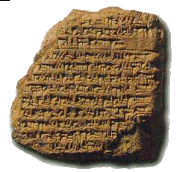 The
first portable writings
we are aware of are clay tablets made in ancient Sumeria. Dried clay
has obvious problems as you cannot bind a bunch of them together. Drop
it and you have dirt. Get it wet and you have mud. The only reason for
the survival of many of the clay tablets is the fact that the archives
they were in burned, and the clay was semi-fired making it more durable. The
first portable writings
we are aware of are clay tablets made in ancient Sumeria. Dried clay
has obvious problems as you cannot bind a bunch of them together. Drop
it and you have dirt. Get it wet and you have mud. The only reason for
the survival of many of the clay tablets is the fact that the archives
they were in burned, and the clay was semi-fired making it more durable.
Cuneiform,
Linear A, and
Linear B were written on clay tablets.
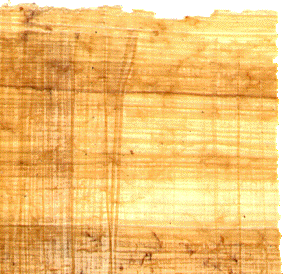 The
second common writing
material seen in the west was Papyrus. This wetlands plant once common
in Egypt was used for many things from woven mats and wall hangings to
a surface to write on. A sheet of papyrus is made from the stem of the
plant. The outer rind is first stripped off, and the sticky fibrous
inner pith is cut lengthwise into thin strips. The strips are then
placed on a hard surface, with their edges slightly overlapping, and a
second layer of strips is laid on top at a right angle. While still
moist, the two layers are hammered together, compressing the layers
into a single sheet. The sheet is then dried under pressure. After
drying, the sheet of papyrus is polished with some hard rounded object.
The resulting surface is not as smooth as paper. The
second common writing
material seen in the west was Papyrus. This wetlands plant once common
in Egypt was used for many things from woven mats and wall hangings to
a surface to write on. A sheet of papyrus is made from the stem of the
plant. The outer rind is first stripped off, and the sticky fibrous
inner pith is cut lengthwise into thin strips. The strips are then
placed on a hard surface, with their edges slightly overlapping, and a
second layer of strips is laid on top at a right angle. While still
moist, the two layers are hammered together, compressing the layers
into a single sheet. The sheet is then dried under pressure. After
drying, the sheet of papyrus is polished with some hard rounded object.
The resulting surface is not as smooth as paper.
Papyrus
several thousand
years of age has been found in Egypt. The material is easy to preserve
in a dry climate. In wetter climates mold quickly attacks the plant
fibers and breaks it down. (See Wikipedia
for further
detail on Papyrus)
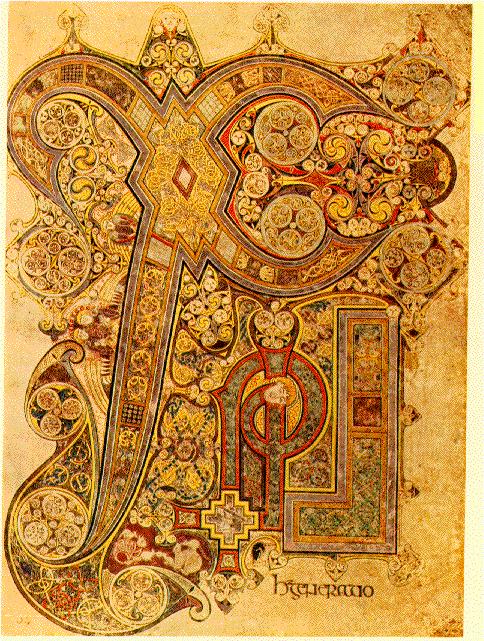 Animal hide was also used as
a writing surface. It was first used in the Ancient period as a
replacement for papyrus, which was getting rare. It was commonly use in
the Medieval period as about the only writing surface. Parchment as it
is commonly called is a difficult to prepare and use medium. Under the
right conditions it can last for centuries, but it is highly affected
by its environment. I have personally handled a deed written in the
Reign of Henry VII. The parchment was stiff, and you could tell that
trying to make it do anything but roll in the direction it had long
been rolled would cause it to crack. The document was still readable
however, if you knew the English of the period.
Animal hide was also used as
a writing surface. It was first used in the Ancient period as a
replacement for papyrus, which was getting rare. It was commonly use in
the Medieval period as about the only writing surface. Parchment as it
is commonly called is a difficult to prepare and use medium. Under the
right conditions it can last for centuries, but it is highly affected
by its environment. I have personally handled a deed written in the
Reign of Henry VII. The parchment was stiff, and you could tell that
trying to make it do anything but roll in the direction it had long
been rolled would cause it to crack. The document was still readable
however, if you knew the English of the period.
Parchment
is made from the
skins of animals, sheep and calves being the most common. Calfskin
parchment is where the word vellum comes from, vitulis
being
the Latin word for calf. It is also the root of the word veal. I will
not go into the methods of preparation here except to note they are
tedious and involved (Not to mention messy). While still made today few
things are written on parchment. (More on Parchment and it's history
can again be found on Wikipedia.)
We can also blame parchment
for the common sizes of books we have today. The various
sizes of the final sheets depended on how many times you folded the
resulting rectangle of tanned hide you got from the sheep. So
the size of the final book was governed by the size of sheep.
When the idea of paper was imported (see below) the sizes
commonly used were retained.
Lastly
we come to
paper. Paper was invented in China and made its way to the west through
Arabia via
traders in the Renaissance. Paper is made from fibers suspended in
solution. What fiber you use can vary. Wood pulp, rice and cloth, both
cotton and linen have been used for paper. US currency is currently
made solely from new cotton.
Paper
is made by passing a
fine screen through a vat of the suspended pulp fibers Depending on the
skill of the paper maker or the quality of the machine that is used the
paper can be thick or thin, smooth or rough.
The
latter is the one of the
main advantages of paper in that the maker has control of the process.
With parchment you get what the animal grows. With paper you decide.
The second advantage is that paper making is an easily automated
process. Once you have the paper making machine you can crank out all
you need. A machine that could make paper with the turn of a crank was
made prior to the industrial revolution.
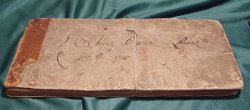 The
lasting qualities or
paper depend on the method used to process the pulp. Sadly the wood
pulp papers of the early 20th century are high in acid content, and the
books made with it are crumbling to dust. Earlier linen pulp papers
last. Books hundreds of years old are still with us and readable. I
have in my library a book of music dated 1784, other than the cover
damage, and obvious heavy use, it is in good condition. (Further
information on paper can be found on Wikipedia). The
lasting qualities or
paper depend on the method used to process the pulp. Sadly the wood
pulp papers of the early 20th century are high in acid content, and the
books made with it are crumbling to dust. Earlier linen pulp papers
last. Books hundreds of years old are still with us and readable. I
have in my library a book of music dated 1784, other than the cover
damage, and obvious heavy use, it is in good condition. (Further
information on paper can be found on Wikipedia).
Other
materials have
been used as I have noted. Before they invented paper the Chinese wrote
on bamboo strips. Egyptians often wrote notes on broken pottery or even
chips of stone. The Romans used everything from imported papyrus, wax
tablets, and thin wood sheets of which hundreds have been found in Vindolanda at
the foot of
Hadrian's Wall.
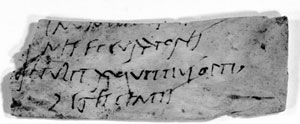
A Roman Letter
Bindings
Once
you have your written
page there is the matter of how to keep them together. Several
solutions have been used throughout the ages. The Chinese tied the
bamboo strips into scrolls. Ancient Tibetan monks would tie the loose
pages between two wood covers, but the sheets are loose between them.
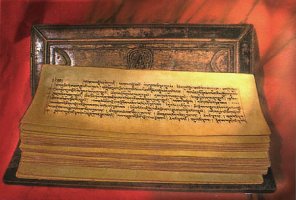
Above: A Tibetian Prayer Book
On the Right: A
chinese bamboo scroll with a
poem.
|
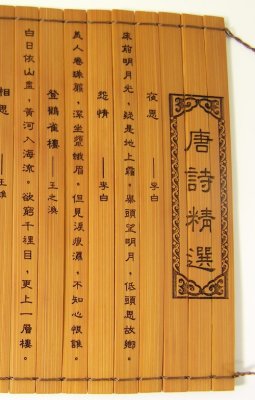
|
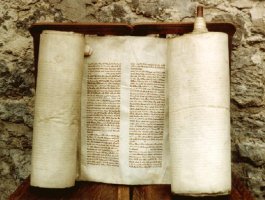 The
first binding commonly
used in Western history is the roll or scroll. Sheets of papyrus or
parchment would be sewn end to end to create a long roll. This was
either rolled loose or wound around a wooden rod for storage. The only
common use of this form today is the Tora scroll used in Jewish
Synagogues. The
first binding commonly
used in Western history is the roll or scroll. Sheets of papyrus or
parchment would be sewn end to end to create a long roll. This was
either rolled loose or wound around a wooden rod for storage. The only
common use of this form today is the Tora scroll used in Jewish
Synagogues.
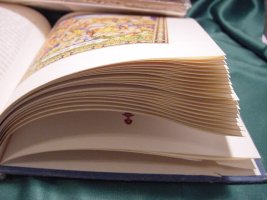 Sometime
along the way
someone got the idea that folding the scroll would make it easier to
handle. So you fold the pages "W" style, sew the inner folds together
and place the whole into a cover. This is the codex. I have
The
Haggadah in this format. Very beautifully illustrated. It is
a
modren copy. However it shows the form. The term is also used for any
bound book of antiquity. I prefer this usage to differentiate the bound
scroll from the book. Sometime
along the way
someone got the idea that folding the scroll would make it easier to
handle. So you fold the pages "W" style, sew the inner folds together
and place the whole into a cover. This is the codex. I have
The
Haggadah in this format. Very beautifully illustrated. It is
a
modren copy. However it shows the form. The term is also used for any
bound book of antiquity. I prefer this usage to differentiate the bound
scroll from the book.
The
problem with the codex is
you only use half the sides to write on. The book is twice as thick as
the number of pages.
The
solution to this
was to take the scroll apart, write on both sides of the sheet and bind
the whole together in what we familiarly call a "book". This kind of
binding has been used with papyrus, parchment and paper.
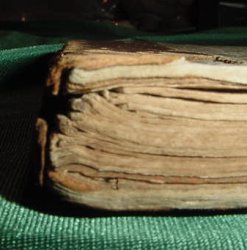 There
are two ways to do this
that are primarily used. One is to bind single sheets with either
thread or glue inside a cover. This is the method commonly used for
paperback books with glue, or older manuscripts written on single
pages, with thread. The other is to print the book on sheets twice the
size of the page desired. Fold the pages into sections or gathers, sew
those together and then sew the sections into the complete book. The
cover is then added. Anyone with old copies of the First Edition
AD&D core books has an example of this method. Looks closely at
the
binding. You can see that the book is made of sections of folded sheets
sewn together. Books made this way are sturdy and will take a great
deal of abuse. Pages do not fall out of them. The image to the right is
of a 200 year old music book that has been hard used. Yes, it has all
its pages, heavy wear and tear aside. There
are two ways to do this
that are primarily used. One is to bind single sheets with either
thread or glue inside a cover. This is the method commonly used for
paperback books with glue, or older manuscripts written on single
pages, with thread. The other is to print the book on sheets twice the
size of the page desired. Fold the pages into sections or gathers, sew
those together and then sew the sections into the complete book. The
cover is then added. Anyone with old copies of the First Edition
AD&D core books has an example of this method. Looks closely at
the
binding. You can see that the book is made of sections of folded sheets
sewn together. Books made this way are sturdy and will take a great
deal of abuse. Pages do not fall out of them. The image to the right is
of a 200 year old music book that has been hard used. Yes, it has all
its pages, heavy wear and tear aside.
The sizes of books as
mentioned under the parchment paragraphs is of interest here.
Below is a table explaining how the various sizes were arrived at.
Keep in mind that folding sheep was hard work.
Those old monks were hard core.
The links in the table will
take you to more complete and confusing information on the sizes of
parchment and paper via wilikpeda that have been used
throughout the history of Occidental paper making. If you
have time to waste the minutia will certainly waste your time.
| Name |
Abbreviations |
Leaves |
Pages |
Book size [h x w] in inches (approx.) |
Size in cm |
| Folio -- One fold of the
sheep |
2° or Fo |
2 |
4 |
15 x 12 |
38.2 x 30.5 |
| Quarto -- Two folds of the sheep |
4° or 4to |
4 |
8 |
12 x 9.5 |
30.5 x 24.15 |
| Octavo -- Three folds of the sheep |
8° or 8vo |
8 |
16 |
9 x 6 |
22.8 x 15.25 |
| Duodecimo or Twelvemo - Four
folds |
12° or 12mo |
12 |
24 |
7 3/8 x 5 |
18.7 x 12.7 |
| Sextodecimo or Sixteenmo -- and so forth. |
16° or 16mo |
16 |
32 |
6.75 x 4 |
17.15 x 10.15 |
| Octodecimo or Eighteenmo |
18° or 18mo |
18 |
36 |
6.5 x 4 |
16.5 x 10.15 |
| Vincesimo-quarto or Twenty-fourmo |
24° or 24mo |
24 |
48 |
-- |
| Trigesimo-secundo or Thirty-twomo |
32° or 32mo |
32 |
64 |
5.5 x 3.5 |
14 x 9 |
| Sexagesimo-quarto or Sixty-fourmo |
64° or 64mo |
64 |
128 |
3 x 2 |
7.6 x 5 |
Collections
Now
that we have touched on
the history and method of the book we will discuss libraries. Everyone
knows of the famous Library of Alexandra, said to have contained all
the wisdom of the Ancients. That was a rare example. In the days before
the printing press. Books were made by hand, and tended to be short. An
ancient book of some fame, The Art of Horsemanship
is about 16
standard pages. A mere pamphlet by modern standards. An extensive
private library could contain as many as a dozen or twenty books. Keep
this in mind if you game world is pre-printing press. Books will be
rare treasures and treasures indeed when found.
 Gutenberg
began the production of his famous Bible in 1452 the year Leonardo
da Vinci was born. He finished that first run in
1455 as the
War
of
the Roses was heating up in England. Incidentally while
trying to make
a profit (he failed) he revolutionized the world. By the mid 1500s a
man could have all the knowledge of the world on his library shelves.
It was, for the first and the last time in history, possible to know
everything. A rich man might have a hundred books, in several languages
and be able to read them all. Gutenberg
began the production of his famous Bible in 1452 the year Leonardo
da Vinci was born. He finished that first run in
1455 as the
War
of
the Roses was heating up in England. Incidentally while
trying to make
a profit (he failed) he revolutionized the world. By the mid 1500s a
man could have all the knowledge of the world on his library shelves.
It was, for the first and the last time in history, possible to know
everything. A rich man might have a hundred books, in several languages
and be able to read them all.
Today
I am looking at more
books on the one subject of role-playing here in my computer room than
the medieval monk would have had on everything. I own more books on
more subjects than the rich man of the Renaissance would have owned, or
could have owned. (There are 247 book on the RPG shelves in my Sanctum.
This does not include the 10 collections of loose "plan" sheets. The
two CD-ROM PDF collections, or the books inside the 13 "boxed sets", or
the books on the shelf above me and computer documentation. I can
reasonably estimate that there are 400 plus books in this room, and
well over 1000 volumes in my house, and I am a light collector among
Fans.) Perhaps amid the plenty, we have forgotten their value.
To
conclude a short history
of the book I have a few tables for randomly creating books in your
game world. A few charts of my own creation and access to the best
subject chart of all, the Dewey Decimal System.
Generation Charts
Type of book: If you do a modern game skip
this part and
assume that all books are paper and either cloth over cardboard or
paper bindings. Really high quality books will be leather bound. You
can use the chart for ancient or unique books.
What is it printed or written on?
| d20 |
Material |
|
|
| 1-7 |
Paper |
|
|
|
1-3 |
Rice |
|
|
4-9 |
Linen |
|
|
10-14 |
wood pulp |
|
|
14-17 |
cotton |
|
|
18-19 |
mix of the above |
|
|
20 |
something different |
|
| 8-13 |
Parchment |
|
|
|
1-8 |
lamb |
|
|
9-16 |
calf |
|
|
17-19 |
goat |
|
|
20 |
other animal |
|
|
|
1-6 |
cervine (deer type) |
|
|
7-12 |
equine (horse type) |
|
|
13-18 |
bovine (other cow type) |
|
|
19 |
human/humanoid |
|
|
20 |
get inventive |
| 14-15 |
Papyrus |
|
|
| 16-17 |
Wood panels |
|
|
|
1-4 |
Linden |
|
|
5-7 |
Rowan |
|
|
8-10 |
Oak |
|
|
11-13 |
Ash |
|
|
14-16 |
Walnut |
|
|
17-19 |
Cherry |
|
|
20 |
other |
|
| 18-19 |
Metal sheets |
|
|
|
1-9 |
Brass |
|
|
10-14 |
Copper |
|
|
15-17 |
Silver |
|
|
18-19 |
Gold |
|
|
20 |
Platinum/mithral |
|
|
|
And are: |
|
|
|
1-5 |
painted |
|
|
6-10 |
embossed (one side only) |
|
|
11-15 |
engraved (both sides) |
|
|
16-20 |
Etched (both sides) |
| 20 |
something else |
|
|
|
1-6 |
Bamboo |
|
|
7-11 |
Ivory |
|
|
12-18 |
Slate |
|
|
19-20 |
unusual or magical stuff |
|
The sheets are bound:
| d20 |
Method |
| 1-2 |
Scroll (obviously does not work with stiff
materials.) |
| 3-4 |
loose |
| 5-12 |
separate sheets sewn |
| 13-18 |
gathers sewn |
| 19-20 |
codex |
The book is bound in:
| d20 |
materials |
|
|
| 1-5 |
Wood (see above for type) |
|
|
|
1-6 |
Bare |
|
|
7-11 |
carved |
|
|
12-15 |
carved and gilded |
|
|
16 |
carved gilded and jeweled |
|
|
17-20 |
covered in |
|
|
|
1-4 |
cloth |
|
|
5-6 |
leather plain (see "parchment" for type) |
|
|
7-8 |
leather tooled |
|
|
9-10 |
leather tooled and gilded |
| 6-10 |
Leather (see "parchment" for type) |
|
|
|
1-8 |
plain |
|
|
9-16 |
leather tooled |
|
|
17-20 |
leather tooled and gilded |
|
| 11-15 |
Cloth |
|
|
|
1-5 |
unstiffened |
|
|
6-20 |
stiffened with |
|
|
|
1-10 leather |
|
|
|
11-20 wood |
|
| 16 |
Ivory (wood backing) |
|
|
| 17 |
stone |
|
|
| 18 |
amber (wood backing) |
|
|
| 19-20 |
Metal with or without wood backing. |
|
|
|
1-9 |
Brass |
|
|
10-14 |
Copper |
|
|
15-17 |
Silver |
|
|
18-19 |
Gold |
|
|
20 |
Platinum/mithral |
|
Condition: How
physically readable is the book?
| 3D6 |
Condition |
3D6 |
Condition |
| 3-4 |
Scraps |
11-12 |
Good |
| 5-6 |
Very poor |
13-14 |
Very good |
| 7-8 |
Poor |
15-16 |
Excellent |
| 9-10 |
Fair |
17-18 |
Mint |
Scraps -- Unreadable, in small
pieces, condition of
many of the dead sea scrolls. Little information can be gleaned from
this work without a great deal of effort, and at that it is only 10% to
80% (d8) complete.
Very poor -- Nearly unreadable, it will be
missing parts.
This book will have pages missing or in fragments, but the majority of
the work is intact. The ink will be faded, and perhaps flaked off in
places. Margins will be worn/torn/burned and may intrude into the text.
The pages may be stained with any sort of matter. The book will be 81%
to 100% complete (d20).
Poor -- Intact but in bad condition, may be
missing the
cover, have bad stains on the pages, tattered pages etc..
Fair -- The book has it's cover and all pages
It can be
care-worn, have loose pages, a broken spine. dog ears etc, but the book
is whole and readable.
Good -- The book may show sign of wear and
heavy use, but
is unbroken or stained.
Very good -- Some signs of shelf wear
Excellent -- The book is as new, but may have
small wear
signs.
Mint -- Just written/printed or looks that
way.
Contents:
Is the information contained on the book accurate? If fiction is it
readable and enjoyable?
| 3D6 |
Quality |
Comments nf=non-fiction f=fiction |
| 3-4 |
Dangerous |
nf -- This book will impart dangerously wrong
information
f -- Rip your eyes out BAD work. |
| 5-6 |
Worthless |
nf -- The book is dead wrong, but not in a way
that
will hurt you.
f -- You would sooner face 100 Orcs than read this book. |
| 7-8 |
Error prone |
nf -- This book has just enough right information
to
hold up the wrong parts.
f -- Well it's read this or bang your head on the wall. |
| 9-10 |
Poorly researched |
nf -- No patently bad data, but it is not well
presented.
f -- "It was a dark and stormy night" |
| 11-12 |
Fair resource |
nf -- Covers the subject well enough for the idly
curious.
f -- A decent light read. |
| 13-14 |
Good resource |
nf -- Covers the subject well enough for the
dilettante.
f -- Engaging |
| 15-16 |
Excellent resource |
nf -- Covers the subject well enough for the
serious
f -- rip the covers off page turner. |
| 17-18 |
Definitive resource |
nf -- No better work on the subject.
f -- classic for the ages. |
Subject: The Dewey Decimal
Classification (DDC) system,
devised by library pioneer Melvil Dewey
in the
1870s is one of the best methods ever for organizing a library. It can
also be used to randomly create the general subject of books found in
treasue. That is our use here. Keep in mind that this is a dynamic
system and is updated monthly. This is not a concern unless you plan to
run a real library.
Unless
one is running a
modern era game the system is not applicable in it's current form
except in the most general categories. This should be considered a
starting off point for the Game Master's own classification efforts
customized to their own world. I have my version of this. It is
presented here as is for your customization.
The
Game Master can be as
complicated, using the whole of the system, or as simple, using only
the d10 roll for the general categories, as they see fit. My method is
to roll 3d10. The first for the general category the other two for the
number in the general category.
000 -- Generalities
100 -- Philosophy & psychology
200 -- Religion
300 -- Social sciences
400 -- Language
500 -- Natural sciences & mathematics
600 -- Technology (Applied sciences)
700 -- The arts
800 -- Literature & rhetoric
900 -- Geography & history
The
rest of the
Dewey Decimal System can be found here.
The complete
system is much longer than I wish to present on my site.
Usage
The
obvious thrust of this is
to use books in your games. We are all familiar with the Necromonicon
of Lovecraft or the Egyptian Book of the Dead, a
book of spells
to get you safely to the afterlife. Likewise the trope of a map or
letter laid within or hidden in a book are common enough.
Herein
are a few books that
the GM can hang plots on.
The Dolmendian Manuscript Unique
Author: unknown.
The
Dolmendian Manuscript is
bound between plain wood plaques with red cord.
This
parchment manuscript of
fourteen pages is a highly stylized book of seven poems each on two
pages. The calligraphic style of the ancient lettering is nearly
impossible to read, and few scholars have puzzled out the verses in
Ancient (your language here). What few realize is that the elongated
and intertwined words form a visual scene when viewed from an oblique
angle. (The top of the book looking down.) Each page is a different
landmark. Taken with the text of the poems it is a map to great
treasure.
This
is usable in any
campaign, magical, modern heroic etc. There is nothing "mystic" about
the book unless the GM inserts it.
The Passages of Enlightenment Unique
Author:
The
Enlightened Prophet.
This
papyrus roll is the
greatest treasure of the majority religion. The text of the sect's holy
book said to be penned in the hand of the Enlightened Prophet himself.
The roll is never read. It is only removed from the richly decorated
reliquary once a year on the high holy day and displayed.
Holy
day is only a month away
and it has been stolen. The thieves are threating to open the roll and
to read from it. The Holy men of the temple are appalled at the
sacrilege. The PCs have been hired to retrieve the scroll at any cost.
It must not be harmed and it must not be opened!
What
do the priests fear? Is
the scroll a fake that contains nothing? Has the sect deviated from the
teaching of the Enlightened Prophet and the powers that be fear a
reading of the Prophets words? Is the scroll simply so old that any
mishandling will destroy this irreplaceable artifact? That is for the
GM to decide.
The Ch'alom Nearly
Unique Author:
unknown
Two
copies of this strange
work are know to exist. One found in the slowly freezing ruins of an
Alien city beneath a white dwarf star. The second located 30 years
later was floating in the Kupler belt of that self same system. The
books are to any scan identical. They are equally puzzling. Each is 31
pages of beaten gold inset in gems. The gems form 89 different
characters and there are 179 characters on each page.
It
is believed that the
Ch'alom is the key to some great treasure. Scientist have studied the
characters for years without coming to any conclusions on the meaning.
There
isn't one. The books do
have meaning, but the characters themselves do not. They are
semi-random. Locked within the mathematics evident in the book is the
key to unlocking the secrets within the molecular structure of the book
itself. The prize? The collected knowledge of this long lost race.
(For
the math challenged 31
is the eleventh prime number, 11 also being prime. 89 is the 13th prime
number after 31 and 179 is the 17th prime number after 89. All these
numbers being prime numbers. There is a code in the structure of the
pages if this pattern is followed. The GM is invited to create the
details of the quest.)
The Garden of Forking Paths rare
Author: Sho Ten Zee
Sho
Ten Zee was a philosopher
who is famous for seldom being understood. Many copies of this book
exist. Most are manuscripts written by madmen, or rather men that
became mad copying it. If your world has the printing press as common,
it may be set to type, the typesetter having gone mad. The covers and
condition vary from copy to copy. There is no common theme. The
original manuscript is written on paper bound loose between wooden
covers and tied with a red silk cord.
The
book is a rambling near
unreadable morass. A casual look will convince the reader that it is
worthless. A more in depth study will reveal that the same tale is told
again and again with endless variations, often as minor as a character
either swatting or not swatting a fly. Deep study of the work indicate
that it is never the same twice. That way lies madness!
The
Garden of Forking Paths
is not a book intended for mortal men. It is tied directly into the
planes of time and chaos. It represents the mutability of the future.
The tales are different with each reading because one cannot know the
future before it happens. If one has a grasp of the necessary magics it
can be used as a focus for time travel into the past, but never the
future.
Many
partial copies also
exist. They are rambling useless works where utter madness overtook the
copier before they finished. It is estimated that only 1d6 complete
books exist.
The Diary of Lucy VonTropenstien unique Author:
Lucy VonTropenstien.
This
book, bound in red
leather and written in the hand of a fine lady, is obviously the work
of a bored noblewoman detailing the trivial matters of her daily life.
It
is nothing of the
sort.
The book is an entire work of fiction intended to hide the true
meaning. If the book is read from back to front, reading only the sixth
sentence of each entry a different tale is told. A tale that if
revealed could bring to ruin the fortunes and honor of an old and
powerful family. A family that would strike back and any such attempt.
Clues do exist within the book to indicate the proper path to the
meaning.
Lucy
has been dead
for 5
years now. It is said she died of a fever, or was in murder, but a
murder done too late to prevent her telling the tale?
A
package containing the book
has just arrived in the hands of a PC. What trail of horror and profane
deeds will they find?
The
Great Bestiary
unique
Author: Abba
Eecreeana
This
massive book is three foot wide and four feet high. It is nearly a
foot and a half thick. The covers are made from black
dragonhide
set with gold, a most striking appearance. It also has a
clasp
and lock. It sits on a stone book stand. When found it
will be closed. This is a Book of Creation, an
always up to
date bestiary. Within can be found an accurate description of every
beast on the planet natural or created. If for some reason a
new
type of creature comes into the world, the book will reflect that at
once.
However
the book is trapped. Without the correct command word and the right
key in the great lock, the book will spew forth beasts to attack
those that attempt to use the book. The lock DC is 12, but the right
key is required to disable the trap as well as the command word. --Excerpt from the
key to Abba Sanctuary.
I
hope the reader
will find inspiration for their own creations within this short
missive. Use more books in your game no matter the genre. I hope that
with these charts they will be easier to create and and detail
sufficiently to be of use to you.
Garry Stahl --June 2006, updated September 2010
Comments or questtons on this file? Mail Here
Return to The
Greyhawke Campaign
Copyright © Garry Stahl: June 2006-2010. All rights
reserved,
re-print only with permission.
|

 The
first binding commonly
used in Western history is the roll or scroll. Sheets of papyrus or
parchment would be sewn end to end to create a long roll. This was
either rolled loose or wound around a wooden rod for storage. The only
common use of this form today is the Tora scroll used in Jewish
Synagogues.
The
first binding commonly
used in Western history is the roll or scroll. Sheets of papyrus or
parchment would be sewn end to end to create a long roll. This was
either rolled loose or wound around a wooden rod for storage. The only
common use of this form today is the Tora scroll used in Jewish
Synagogues.
 Gutenberg
began the production of his famous Bible in 1452 the year Leonardo
da Vinci was born. He finished that first run in
1455 as the
War
of
the Roses was heating up in England. Incidentally while
trying to make
a profit (he failed) he revolutionized the world. By the mid 1500s a
man could have all the knowledge of the world on his library shelves.
It was, for the first and the last time in history, possible to know
everything. A rich man might have a hundred books, in several languages
and be able to read them all.
Gutenberg
began the production of his famous Bible in 1452 the year Leonardo
da Vinci was born. He finished that first run in
1455 as the
War
of
the Roses was heating up in England. Incidentally while
trying to make
a profit (he failed) he revolutionized the world. By the mid 1500s a
man could have all the knowledge of the world on his library shelves.
It was, for the first and the last time in history, possible to know
everything. A rich man might have a hundred books, in several languages
and be able to read them all. The
first portable writings
we are aware of are clay tablets made in ancient Sumeria. Dried clay
has obvious problems as you cannot bind a bunch of them together. Drop
it and you have dirt. Get it wet and you have mud. The only reason for
the survival of many of the clay tablets is the fact that the archives
they were in burned, and the clay was semi-fired making it more durable.
The
first portable writings
we are aware of are clay tablets made in ancient Sumeria. Dried clay
has obvious problems as you cannot bind a bunch of them together. Drop
it and you have dirt. Get it wet and you have mud. The only reason for
the survival of many of the clay tablets is the fact that the archives
they were in burned, and the clay was semi-fired making it more durable. The
second common writing
material seen in the west was Papyrus. This wetlands plant once common
in Egypt was used for many things from woven mats and wall hangings to
a surface to write on. A sheet of papyrus is made from the stem of the
plant. The outer rind is first stripped off, and the sticky fibrous
inner pith is cut lengthwise into thin strips. The strips are then
placed on a hard surface, with their edges slightly overlapping, and a
second layer of strips is laid on top at a right angle. While still
moist, the two layers are hammered together, compressing the layers
into a single sheet. The sheet is then dried under pressure. After
drying, the sheet of papyrus is polished with some hard rounded object.
The resulting surface is not as smooth as paper.
The
second common writing
material seen in the west was Papyrus. This wetlands plant once common
in Egypt was used for many things from woven mats and wall hangings to
a surface to write on. A sheet of papyrus is made from the stem of the
plant. The outer rind is first stripped off, and the sticky fibrous
inner pith is cut lengthwise into thin strips. The strips are then
placed on a hard surface, with their edges slightly overlapping, and a
second layer of strips is laid on top at a right angle. While still
moist, the two layers are hammered together, compressing the layers
into a single sheet. The sheet is then dried under pressure. After
drying, the sheet of papyrus is polished with some hard rounded object.
The resulting surface is not as smooth as paper. Animal hide was also used as
a writing surface. It was first used in the Ancient period as a
replacement for papyrus, which was getting rare. It was commonly use in
the Medieval period as about the only writing surface. Parchment as it
is commonly called is a difficult to prepare and use medium. Under the
right conditions it can last for centuries, but it is highly affected
by its environment. I have personally handled a deed written in the
Reign of Henry VII. The parchment was stiff, and you could tell that
trying to make it do anything but roll in the direction it had long
been rolled would cause it to crack. The document was still readable
however, if you knew the English of the period.
Animal hide was also used as
a writing surface. It was first used in the Ancient period as a
replacement for papyrus, which was getting rare. It was commonly use in
the Medieval period as about the only writing surface. Parchment as it
is commonly called is a difficult to prepare and use medium. Under the
right conditions it can last for centuries, but it is highly affected
by its environment. I have personally handled a deed written in the
Reign of Henry VII. The parchment was stiff, and you could tell that
trying to make it do anything but roll in the direction it had long
been rolled would cause it to crack. The document was still readable
however, if you knew the English of the period. The
lasting qualities or
paper depend on the method used to process the pulp. Sadly the wood
pulp papers of the early 20th century are high in acid content, and the
books made with it are crumbling to dust. Earlier linen pulp papers
last. Books hundreds of years old are still with us and readable. I
have in my library a book of music dated 1784, other than the cover
damage, and obvious heavy use, it is in good condition. (Further
information on paper can be found on
The
lasting qualities or
paper depend on the method used to process the pulp. Sadly the wood
pulp papers of the early 20th century are high in acid content, and the
books made with it are crumbling to dust. Earlier linen pulp papers
last. Books hundreds of years old are still with us and readable. I
have in my library a book of music dated 1784, other than the cover
damage, and obvious heavy use, it is in good condition. (Further
information on paper can be found on 


 There
are two ways to do this
that are primarily used. One is to bind single sheets with either
thread or glue inside a cover. This is the method commonly used for
paperback books with glue, or older manuscripts written on single
pages, with thread. The other is to print the book on sheets twice the
size of the page desired. Fold the pages into sections or gathers, sew
those together and then sew the sections into the complete book. The
cover is then added. Anyone with old copies of the First Edition
AD&D core books has an example of this method. Looks closely at
the
binding. You can see that the book is made of sections of folded sheets
sewn together. Books made this way are sturdy and will take a great
deal of abuse. Pages do not fall out of them. The image to the right is
of a 200 year old music book that has been hard used. Yes, it has all
its pages, heavy wear and tear aside.
There
are two ways to do this
that are primarily used. One is to bind single sheets with either
thread or glue inside a cover. This is the method commonly used for
paperback books with glue, or older manuscripts written on single
pages, with thread. The other is to print the book on sheets twice the
size of the page desired. Fold the pages into sections or gathers, sew
those together and then sew the sections into the complete book. The
cover is then added. Anyone with old copies of the First Edition
AD&D core books has an example of this method. Looks closely at
the
binding. You can see that the book is made of sections of folded sheets
sewn together. Books made this way are sturdy and will take a great
deal of abuse. Pages do not fall out of them. The image to the right is
of a 200 year old music book that has been hard used. Yes, it has all
its pages, heavy wear and tear aside.